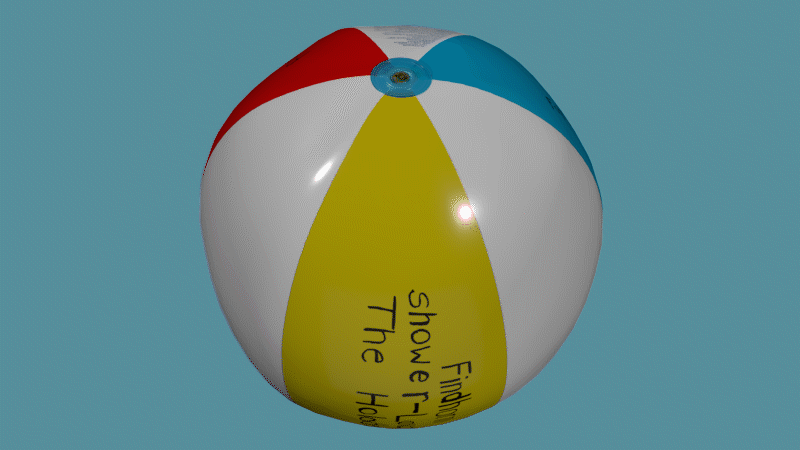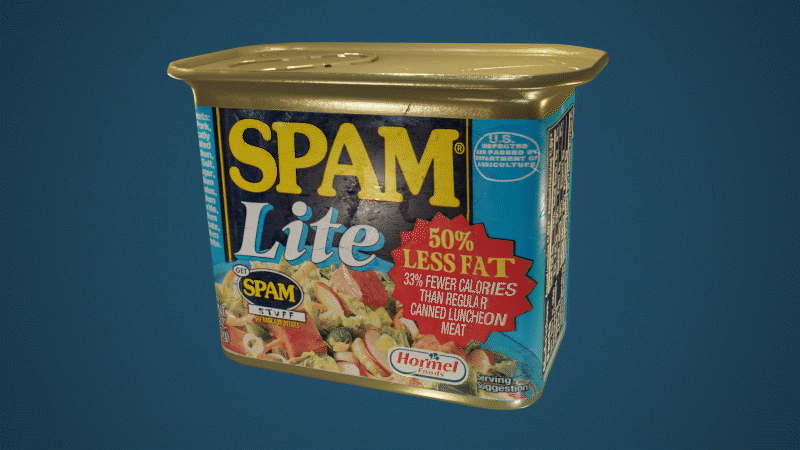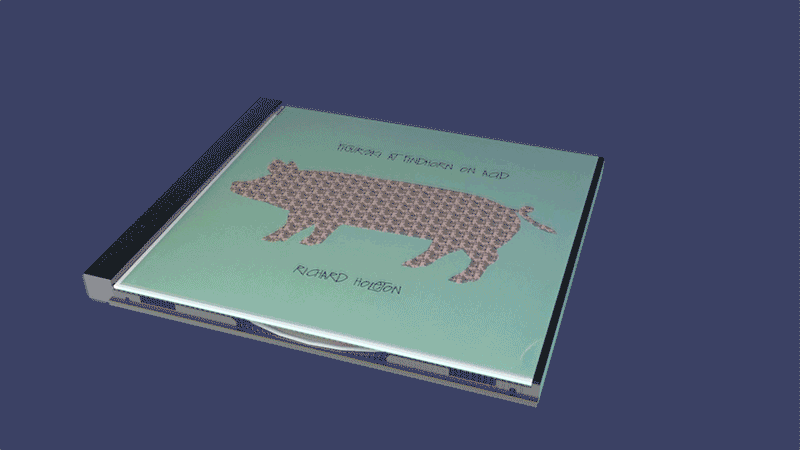The wonder of this hypertext is that it rigidly sticks to an extremely complicated, even
tortured, organization (in
which every possible arrangement of three characters, three objects and three places occurs) and yet it is a
good
read—whether you mechanically follow the default route or flip around randomly, you can zip through and
enjoy the
pages. Somehow Holeton has managed to integrate the mechanical structure, absurd philosophical ruminations,
characters
defined entirely by eccentricities, and intellectual metafictional commentary into a seamless whole.
The only way to explain the way this text works is to give an example: the characters discover Rosellini’s
1737
Mechanical Pig, which is quite clearly identified as a metaphor for the whole hypertext (e.g., the pig is
constructed in
three sub-assemblages, each of which has three parts in it, and so on, just like the text); the most
important quality
of this machine pig is that it can imitate both eating and excreting, so that its various owners stage
performances
which climax in the pig's eating real food and then producing what appears to be excrement, to the delight
of audiences.
Holeton's use of this meta-fictional pig is both deeply philosophical and utterly self-mocking: it raises
such central
questions about computer texts as the line between the mechanical and the organic, and at the same time
laughs at anyone
(including the author) who would describe this text as raising any cosmic questions at all.
Let me elaborate a bit on the pig to show how far Holeton carries the meta-fictional issues: another object
repeatedly
brought up in the text is the substance Spam, which is described as created by repeatedly chopping pieces of
pork into
threes (again, an image of the process of writing this endlessly divided-into-threes text). So the process
of
mechanically chopping up his stories which became Holeton's method in writing this hypertext novel is mocked
by Holeton
as his way of producing "processed literature"—Spamfiction. But what then do we make of a scene where the
mechanical
pig is fed Spam? If the pig and Spam are metaphors for the creation of hypertexts, is the scene of a
mechanical pig
eating Spam a metametaphor, a metaphor for the processing of metaphors? Is a mechanical pig eating processed
pork a
twenty-first century version of Stanley Fish's critical category of the self-consuming artifact? Or is it
just comical?
Holeton manages to ride a thin edge between the most complex recent critical ideas and the most absurd TV
game shows. It
is remarkable enough that Holeton shows us such a thin edge exists, more remarkable that he would seek to
create new
literature in such a strange region, and most remarkable that what he writes is great fun to read.
While the novel was being completed, I assigned it to students at Bryn Mawr College (and an allusion to this
appears in the text in reference to a Professor Ratnert—anagram for Tratner). Students found the novel
enjoyable, but they concluded that the really striking thing about it is that its "difficulty," the depth of
its commentary on modern culture, derives from its being "too easy" and "too accessible"—it is a work made
of easy, accessible cultural materials, yet it resists the usual ways we consume or dismiss such materials.
As the students noted, while enjoying the absurdity of the text, there are repeatedly references to real
sociopolitical
issues and even to horrors. The main characters are defined by painful experiences that have in some ways
ruined their
lives: Francis Figurski is driven to murder by the way he is used by academia in graduate school; Nguyen Van
Tho had his
hands blown off during the Vietnam war; Fatima Michelle Vieuchanger faces misogyny, ethnic marginalization
and has lost
custody of her son to her husband. The text takes us into their minds as they repeatedly recall painful
experiences.
Figurski thinks back to his time as a graduate student: “the graduate studies office is hassling you even
though you’ve
told them repeatedly to get off your back . . . and your advisor is fucking with your mind . . . and your
registration
is on hold again . . . and Harvard pays its ta’s 8.5% of pigshit wages, how long before you smash in his
fucking head”
(1.1.05). When Tho takes acid, he both remembers the explosion that blew off his hands and experiences
“Double phantom
limb symptoms . . . including intermittent pain”; the text then asks whether reading about such experiences
could cause
readers to themselves suffer “American post-Vietnam anxieties” (1.3.06). Fatima on acid struggles to “Avoid
unpleasant
thoughts — fear of heights, losing control, death, pain, misery. Don’t think about Mo [her son
Mohammed],
those huge
brown eyes, the guilt!” (1.1.22).
The text also makes passing mention of numerous global political issues, only occasionally connected to the
main
characters. In the middle of a fairly innocuous page, there are Canadians chanting “Vietnam, Nicaragua, El
Salvador,
Granada, Iraq, Palestine” (1.2.06)—all locations of concern in international politics in 1999, when the
novel was
written. Later we have an eruption of political commentary in the midst of a general account of the rise of
acid as a
popular drug: “Acid use declined during the fraudulent wars on drugs initiated by the Reaganites, who
instead favored
crack cocaine, promoted by the CIA as part of the effort to addict and imprison America’s entire ethnic
underclass”
(Acid 2.x). And toward the end of the novel, in the Notes, Fatima Vieuchanger provides another summary of
issues of the
day: “resist the war, protect the environment, liberate women and other oppressed groups, legalize drugs,
etc.” (126).
But she reaches an unusual conclusion: “Morocco is America’s future (not the other way around). Morocco is
run by the
wealthy few, its great urban population a mass of low-level merchants . . . This is where you are going, it
is
practically where you are, but your media keep you in the dark” (126). There are numerous such political
commentaries,
and the horrors of the main characters are disturbing, but somehow nothing quite dispels the general tone of
absurd
entertainment.
We might expect the presentation of sociopolitical issues to be due to the misuse of power, but the text
essentially
never devotes more than a sentence here and there to leaders of any sort. There are no evil powerful figures
having a
significant role in the novel. Rather the text follows the postmodern theorist Jean Baudrillard’s conclusion
in
Simulacra and Simulations that “power is no longer present” in modern society; power has been
“completely
expunged from
the political dimension, it is dependent, like any other commodity, on production and mass consumption”
(179).
Production and mass consumption—or we might say the production of those things which are mass consumed—is
endlessly
examined in this novel, and the novel suggests, as Baudrillard does, that such mass consumption is what is
creating the
political and personal horrors of the current world. The novel suggests that individuals are simply
surrounded by
mass-produced objects and distant government agencies, so that individuals have very little agency. One
“assignment”
supposedly for a class reading this highlights this division: “break down communication barriers between
individual
consumers and impersonal bureaucracies or cultural icons” (1.3.08). A central theme of the novel is that
bureaucracies
and icons substitute for actual communication—we think in provided symbols.
Turning to postmodern theory to make some sense of this work is not just what I as an English professor tend
to do.
Rather, postmodern theory is brought in directly by Holeton: at one point a “conference” is on the topic of
“The Writer
as Simulation” and concludes that “in a virtual Baudrillardian Disneyland-on-drugs, The Writer is a
simulation of a
simulacrum” (2.2.08). Holeton is drawing on Baudrillard’s discussion of Disneyland as one way the totality
of
simulations are covered up: by appearing to be different from the rest of the world because it is entirely
composed of
obvious copies, Disneyland functions to make the simulations functioning outside Disneyland appear to be
“real.”
Holeton’s text can be used to do very much what Baudrillard suggests Disneyland does: it gives us the
experience of a
world entirely full of copies, and we generally react to it as absurd, unlike reality, but that is precisely
how the
novel misleads us. The novel seems unreal, but yet also suggests in many ways—such as citing
Baudrillard—that to see
the world of copies in the text as unlike what is “real” is misreading the text.
Baudrillard attributes the turning of the world into simulations to the effects of late Capitalism.
Capitalism long ago
was concerned with what could really be constructed, with production of real things. But the rise of the
infinite
variety of ways to modify construction, to make copies of copies and give them value, has changed that. So
Baudrillard
concludes,
“if it was capital which fostered reality, the reality principle, it was also the
first to liquidate it in
the
extermination of every use value, of every real equivalence, of production and wealth, in the very sensation
we have of
the unreality of the stakes and the omnipotence of manipulation.” (178)
What Holeton is investigating in much of this work is the “omnipotence of manipulation”—and it is by making
us extremely
aware of HIS manipulations that the work aims to give us a Baudrillardian reading of the Disneyland that is
this text:
we can never lose sight of the sociopolitical issues being manipulated by the very Disney-like creations in
this work
and in the world around us.
The novel thus is a form of criticism that applies to itself as much as to the world at large. Linda
Hutcheon, in The
Politics of Postmodernism, has called this feature of postmodern literature “complicitous critique”
(2), and
regards it
as the crucial structure of parody: “In postmodern parody, the doubleness of the politics of authorized
transgression
remains intact: there is no dialectic resolution or recuperative evasion of contradiction” (106). Following
Hutcheon’s
views, we have to conclude that there is no way to settle on the precise commentary Holeton’s hypertext is
making about
the world around us. The work is political, and it is pure entertainment, and these seemingly disparate
halves are
deeply entwined or “complicitous” with each other. To see how deeply the two halves are bound together, I
suggest
looking more closely at how Spam is used. It is a well-known cheap product that may seem to consist of
rather fake meat.
But Spam turns out to play numerous roles in the novel. It is an empty Spam container that holds the bomb
that blows off
Tho’s hands. That suggests that it is not only the Viet Cong who have injured Tho, but American products,
distributed
worldwide. On the other hand, Spam is also the container in which the “Prime Movers” are found which could
restore the
mechanical pigs and thus in a sense restore the full order of the entire work. A Prime Mover is something
that is
essentially a beginning, a first principle, a center, something that clearly is not a copy (though there
seem to be two
Prime Movers, one for each mechanical pig). The novel thus presents Spam as a vast source of social
corruption and as
having the potential to carry inside it an answer, a cure for all the simulations surrounding us. Rather
neatly, Holeton
even extends his world to include two fake containers of meats with names based on Spam but slightly
changed, one simply
called “Sham” and the other named by reversing the spelling to produce “Maps.” To see Spam as a Sham is to
get beyond
its commercially promoted meaning as a good form of meat. To see it in relation to maps, on the other hand,
is striking
and strange—does Spam provide directions to something we should care about? Putting Spam in the middle
between Sham and
Maps leaves us uncertain where we might go in thinking about Spam—just see it as a worthless cultural icon,
a false
version of useful food? Or see it as something that could lead us somewhere, perhaps out of the entire world
of cultural
icons? Holeton has filled this work with popular culture icons which he can then use both for their corrupt
involvement
in world problems and for criticism of that very corruption.
Another postmodern theorist, Jacques Derrida, argues in a dense essay entitled “Structure, Sign, and Play
in the
Discourse of the Human Sciences” that an actual “event” in recent history has led to the sense that
everything is a
copy. And that event was what Derrida calls a “rupture” in the very nature of “structure” itself. Derrida
argues that to
have an overall structure, there must be a center, something that is beyond the process of defining things
in terms of
other things, something that just is itself, something that just is a “presence” not needing definition in
terms of
anything else. Derrida includes a long list of things that have served as that central presence in the
history of
various structures. He says,
“It could be shown that all the names related to fundamentals, to principles, or to
the center have always designated an
invariable presence—eidos, arché, telos, energeia, ousia (essence, existence,
substance, subject) aletheia,
transcendentality, consciousness, or conscience, God, man, and so forth.” (177)
However, Derrida argues that after the critiques of all those “centers” by writers such as
Nietzsche, Freud, and Heidegger, it is impossible to believe in any “presence,” anything that everyone
experiences as
just itself. Instead, there is only now “repetition in all of the senses of the word” (178). When
“repetition” replaced
“structure,” Derrida says people began “thinking that there was no center . . . that it was not a fixed
locus but a
function, a sort of nonlocus in which an infinite number of sign-substitutions came into play” (178).
Holeton’s novel is clearly about such a vision of the world, but it is not merely about endless copies. Much
of the
novel is about the search for a center—which is turned into the search for a fully-assembled mechanical pig.
The pigs
are of course copies, and one even a copy of the other pig, but what they are supposed to be able to do is
perform a
central “natural” operation which is part of every animal: taking in food and converting it to excrement. If
they can do
that, they start to seem no longer merely copies, but versions of the original, i.e., of real pigs. The text
describes
pigs, humans and all animals as part of the “meat-world” and as “meat,” they are all distinct individuals
because they
are born through a “meat” process, a process that transforms parts of the parents into parts of the newborn,
and all
those parts are distinct, not mere repetitions. The natural processes of incorporating and transforming
physical
substances never fully repeat the composition of what results. As such, things making up the “meat-world”
cannot be
fully “copies” of anything. Reconstructing the pigs to properly digest food is then part of an escape from
the universe
of copies. It even turns out that the key mechanical piece needed to have the pigs work is called the “Prime
Mover,”
identifying the fully assembled pigs with precisely what Derrida says has been lost—a central “presence”
that needs
nothing beyond it to define it, a first or prime mover which starts the process of building things out of
other things
and thus the process of creating copies. The latter part of the novel, seeking to insert a prime mover and
transform a
constructed object into a naturally functioning living thing (a pig consuming food) thus raises the question
of whether
it is possible to reconstruct a center and restore “structure” to the world of endless simulations. But it
is impossible
to get a “center” by reconstructing the pigs, because there are two of them and it is impossible to tell
which is the
“original” and which the “copy.” The same uncertainty surrounds the “Prime Movers” which operate the pigs:
if there are
two, neither can be the singular “center” that Derrida says is gone: even a Prime Mover can be copied within
the
structure of the world of the novel. The work itself thus cannot achieve the “structure” that it is in some
sense deeply
desiring.
But something else happens that counters the hopelessness of what seems for much of the work a
Baudrillardian vision of
the meaninglessness of everything being a simulation. What happens is that the novel has a definite sense of
beginning
and ending, which does not “structure” the whole, but hints at an alternative to the chaos which Baudrillard
condemns
and Derrida in a sense welcomes.
The first few pages of the novel operate in large part as a fairly traditional beginning. One gets
introduced to the
characters, the places, and the strange objects that people use in those places, all well-defined, in fat
paragraphs
with no notes on pages neatly titled Figurski 1.x, Findhorn 1.x, Acid 1.x, etc. So a reader begins the novel
with a
reasonably clear sense of the pieces that make up the story. There are also a few “scenes” using those
pieces, and
gradually the scenes take over. The scenes have links to the Notes, and the first few notes quite directly
speak of a
beginning. The very first note says, “The doorway to another reality lies before you” (001)—we are readers
are being
led into “another reality.” And the fifth note is a quote from an article in a journal called Technology and
Culture,
but it seems to set out what will follow in Holeton’s work: “Our story begins with the deep-rooted urge of
man to
simulate the world about him through the graphic and plastic arts . . . The design is a mathematical
tour-de-force in
elegantly mapping the heavenly vault” (005). And illustrating that quote are eerie images of diagrams that
look like the
charts for sections of the novel, but made into curves that seem to be hanging or spinning in space. The
seventh note
says, “In some versions the pigs eventually regain their human shape” (007), hinting at the ambiguity that
persists
throughout the work about just what the mechanical pigs are. And note 14 quotes Lewis Mumford saying that
the extensive
growth of technology has created a world in which we might say there is a new kind of center: “the center of
authority .
. . lies in the system itself, invisible but omnipresent” and all humans are “themselves trapped by the very
perfection
of the organization they have invented” (014). These notes set up what becomes the central concern of the
overall
work—is there a structure? A structure to the novel? A structure to the vast array of cultural icons and
entertainment
figures? A structure to the world of sociopolitical issues? A structure to human reality?
After introducing the major features of the text in the pages and raising questions about the possibility
that it is
exploring an overall structure, the text then wanders off into numerous amusing or bizarre sections—a series
of parodies
of Nancy Drew mysteries; several “conferences” where academics discuss various elements of the novel;
Holodeck programs
recreating Princess Di’s death in an auto accident; and so on.
But the final sections of the novel don’t just wander: they move to a sense of a distinct ending, though not
one that
recovers an overall structure to the world or to the whole work. All the characters go onto the Holodeck to
turn into
the people they had been copying: they are described as then “role-playing their meat-world twins” (3.1.06).
In a sense,
the novel seems to be undoing its copying, as if it were attempting to return to “reality”—to the solid
“meat” shapes of
these people that cannot simply be copied. But of course it is the Holodeck creating copies of those
“originals” and
putting those new copies over the old copies which were the characters, so it is not a restoration of the
original
“meat” existence. But for a while the three characters are in a sense no longer creations of the text. After
that all
three characters become actively involved in seeking to reassemble the mechanical pigs; they succeed in
producing “fully
functional” pigs (3.3.03), but as with the people, what appears unique—a pig with a Prime Mover inside—is
indistinguishable from a copy.
There is then at the end no complete structure but there is an ending: the pages and the notes change to
something else
in the last section. The text becomes “picture book” illustrations—cute crayon drawings as if done by
children— and
the very last page has a whole series of repetitions of the words “goodbye” and “goodnight” including
“goodnight moon,”
the title of a famous children’s book (3.3.03). The turn to a young child’s “picture book” after all the
complexity and
intellectualism in the novel is in some ways sad and in other ways hopeful—the work has sought to go beyond
the endless
repetition of the sociopolitical order, an endless repetition that makes all the problems and all the good
stuff in the
world seem “old.” But the goal of the work, the last section suggests, is to produce something young and
new. And if it
could do that, it would end up creating something we adults cannot fully understand, but we can join in the
spirit of
saying goodbye to a powerful and quite enjoyable text, and with the hope that we are also saying some form
of goodbye to
the sociopolitical monstrosities it has alluded to throughout.
The Notes, which in the beginning set out multiple versions of an overall structure to the universe, turn
at the end to
various images of ending without completing any particular structure. The final section of Notes is titled
“time/end
o’journey.” The first one alludes to “reviewing, re-envisioning each scene” which it says “isn’t possible on
the
outside, in the meat world” (130). The second one refers to the possibilities of revising and changing all
sorts of
earlier moments in the text, but including some overall conclusions such as “politics IS cannibalism” (131).
The notes
then move to the images of Berber and Moroccan places, such as “kasbahs and . . . [a] ruined mosque” (144).
Then the
final note is presented as a Moroccan way of ending, of saying good-bye—via a move to religious language.
First it says
that “Good-bye . . . means “God be with ye” (147). And then it claims to present a Moroccan version of
goodbye, “Slama
Sidhi Barakhas” which the note translates as “Peace be with you, my friend, and blessings on you” (147).
The final words of both pages and notes thus seem to be directly addressing the reader to provide a
distinctive kind of
ending—not resolution of any of the plot elements, but just a peaceful separation. The reader, assumed to be
an adult
American, is in a sense being encouraged to imagine a new generation and the possibility of leaving the
world the reader
knows to go, we might say, beyond culture altogether. The novel ends with the possibility of something we
could call
“somewhere else,” but possibly currently unknown, created perhaps by people who are young and not yet
entirely wrapped
up in the vast corporate simulations which the work has explored so deeply. Such is the hypertext novel’s
answer to
postmodern despair.
Works Cited
Baudrillard, Jean. “Simulacra and Simulations.” Jean Baudrillard, Selected
Writings. Ed. Mark Poster.
Stanford: Stanford
University Press. 1988. 166-183.
Derrida, Jacques. “Structure, Sign, and Play in the Discourse of the Human Sciences.” Modern Literary
Theory: A Reader.
Third Edition. Ed. Philip Rice and Patricia Waugh. New York: St. Martin’s Press. 176-191.
Fish, Stanley. Self-Consuming Artifacts: The Experience of Seventeenth-Century
Literature. Berkeley:
University of
California Press. 1972.
Hutcheon, Linda. The Politics of Postmodernism. 2nd edition. New York:
Routledge. 1989.

Fig. 3. GIF of the beach ball used for live performances of Figurski, modeled
by Andrew Templin, Creative Media and Digital Culture program at WSUV, 2021.





























